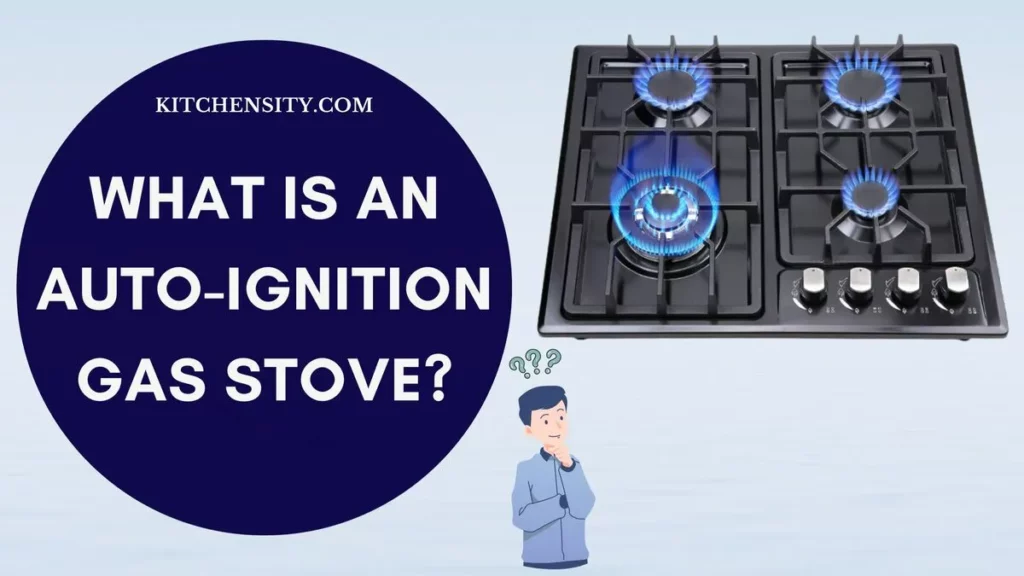In today’s fast-paced world, convenience and efficiency are key factors in choosing home appliances.
One such innovation in the culinary world is the auto-ignition gas stove. This advanced cooking device has gained immense popularity due to its user-friendly features and time-saving capabilities.
In this article, we’ll explore what an auto-ignition gas stove is, how it works, its benefits, and why it might be the perfect addition to your kitchen.

Table of Contents
- 1 What Is An Auto-Ignition Gas Stove?
- 2 How Does Auto-Ignition Work In The Gas Stove?
- 3 How To Use Auto-Ignition Gas Stove?
- 4 Does The Auto Ignition Gas Stove Starts Without Electricity?
- 5 Is Auto-Ignition Gas Stove Better?
- 6 Does Auto-Ignition Gas Stoves Use Battery?
- 7 Auto-Ignition Kit For Gas Stove
- 8 Can Lighter Be Used In Auto-Ignition Gas Stoves?
- 9 Final Thoughts: What Is An Auto-Ignition Gas Stove?
- 10 Frequently Asked Questions (FAQs)
- 10.1 Can An Auto-Ignition Gas Stove Be Converted To Manual Ignition?
- 10.2 Are Auto-Ignition Gas Stoves More Expensive Than Traditional Gas Stoves?
- 10.3 Can I Install An Auto-Ignition Gas Stove On My Own?
- 10.4 Are Auto-Ignition Gas Stoves Compatible With All Types Of Gas Connections?
- 10.5 Is It Necessary To Turn Off The Gas Supply When Not Using An Auto-Ignition Gas Stove?
What Is An Auto-Ignition Gas Stove?
An auto-ignition gas stove is a modern kitchen appliance equipped with an advanced ignition system. Unlike traditional gas stoves that require external lighters or matches to ignite the burner, auto-ignition stoves have a built-in ignition mechanism. When the burner knob is turned, this system generates a spark, ignites the gas, and creates a flame for cooking. This feature enhances safety, eliminates the need for manual lighting, and simplifies the cooking process, making it convenient and user-friendly for individuals of all ages.
Also Read – Butane Vs Propane Stove
Advantages Of An Automatic Ignition Gas Stove
Automatic ignition gas stoves offer several advantages, making them a popular choice among consumers. Here are some of the key benefits:
- Convenience: One of the most significant advantages of automatic ignition gas stoves is their convenience. They eliminate the need for external sources like lighters or matches, allowing users to ignite the burner with a simple turn of the knob. This streamlined process saves time and effort in the kitchen.
- Enhanced Safety: Automatic ignition stoves come with safety features such as flame failure detection and gas leakage sensors. These mechanisms automatically shut off the gas supply if there’s no flame or if a leak is detected, minimizing the risk of accidents and ensuring a safe cooking environment.
- Energy Efficiency: These stoves are designed to be energy-efficient. The ignition system uses minimal energy to generate the spark, contributing to reduced electricity consumption. This not only saves energy but also lowers utility bills, making them an economical choice in the long run.
- Time-Saving: With automatic ignition, the burner lights up instantly, enabling users to start cooking immediately. This feature is particularly beneficial for busy individuals and families, allowing for quick meal preparation without any delays.
- Easy Maintenance: Automatic ignition gas stoves are low-maintenance appliances. The absence of external lighters or matches reduces clutter around the stove, making cleaning and upkeep hassle-free. This simplicity in design translates to easier maintenance for users.
- User-Friendly: These stoves are user-friendly, especially for individuals who might have difficulty using traditional ignition methods. The intuitive design and effortless ignition process make them accessible and easy to use for people of all ages.
- Sleek Aesthetics: Automatic ignition gas stoves often come with modern and sleek designs, enhancing the overall aesthetics of the kitchen. They add a touch of sophistication to the culinary space, making them a popular choice for homeowners who prioritize both functionality and style.
Also Read – Brass Burners Vs Cast Iron Burners
Auto-Ignition Gas Stove Problems
Auto-ignition gas stoves, while convenient and efficient, are not without their potential issues. Here are some common problems associated with auto-ignition gas stoves:
- Ignition Failure: One of the primary issues faced by users is the failure of the ignition system. This can happen due to a faulty ignition switch, wiring problems, or worn-out ignition components. When the ignition fails, users have to resort to manual methods for lighting the stove, defeating the purpose of the auto-ignition feature.
- Continuous Clicking Noise: Some users report a continuous clicking sound even after the burner has been lit. This persistent clicking noise can be irritating and may indicate a malfunction in the ignition system. It could be caused by moisture, dirt, or a misaligned ignition switch.
- Uneven Flame: Auto-ignition stoves might develop issues where the flame is uneven, either too high or too low. This problem can lead to uneven cooking and is often caused by clogged burner ports or irregular gas flow due to a faulty regulator.
- Delayed Ignition: Another problem faced by users is delayed ignition, where there is a noticeable delay between turning the knob and the burner igniting. This delay can disrupt the cooking process and might be caused by issues with the ignition system or gas supply.
- Sensitivity To Moisture: Auto-ignition systems can be sensitive to moisture. If water or any liquid spills near the ignition components, it can lead to ignition problems. Moisture can cause short circuits or corrosion, affecting the proper functioning of the ignition system.
- Gas Smell: A gas smell near the stove, even when it’s turned off, is a cause for concern. This could indicate a gas leak, which poses a significant safety risk. Gas leaks can occur due to damaged gas lines, faulty valves, or worn-out seals in the stove.
- Continuous Ignition: In some cases, the ignition system might keep sparking even after the burner is lit. This continuous sparking can damage the ignition components and is often caused by a faulty ignition switch or a short circuit.
- Difficulty In Repair: Auto-ignition systems are complex, and repairing them requires expertise. DIY repairs can lead to further damage or safety hazards. Finding a qualified technician to fix these issues can be challenging, especially in areas with limited appliance repair services.
Also Read – Brass Burners Vs Stainless Steel Stove Burners
How Does Auto-Ignition Work In The Gas Stove?
Auto-ignition in a gas stove operates through a combination of electrical components and gas flow. When you turn the knob on an auto-ignition stove, it activates an electrical switch. This switch, in turn, triggers a spark generator. This generator produces a small electric spark.
Simultaneously, as you turn the knob, gas starts flowing from the burner. When the spark generator creates the spark, it ignites the flowing gas, instantly creating a flame on the burner. This process happens almost instantaneously, allowing for quick and effortless ignition of the stove.
In more advanced models, there is a safety feature known as flame detection. Near the burner, there is a sensor that can detect the presence of a flame. If the sensor doesn’t detect a flame within a certain timeframe after the ignition attempt, it sends a signal to shut off the gas supply. This safety mechanism ensures that gas doesn’t continue to flow if the flame fails to ignite properly, preventing potential hazards like gas leaks.
So, auto-ignition in gas stoves combines an electrical circuit with a spark generator and gas flow. This automation eliminates the need for external ignition sources, providing a safe, convenient, and efficient way to light the stove.
Also Read – Can You Paint Gas Stove Grates?
How To Use Auto-Ignition Gas Stove?
Using an auto-ignition gas stove is incredibly simple and convenient. Here’s a step-by-step guide on how to use it:
- Check For Safety: Before you start, ensure there are no gas leaks in the kitchen. If you smell gas, ventilate the area and do not attempt to use the stove. Contact a professional for assistance.
- Place Cookware: Put the cookware or utensils you intend to use on the burner. Make sure they are placed securely and are appropriate for the type of cooking you plan to do.
- Turn The Knob: Locate the burner knob on the stove. To ignite the burner, turn the knob of the desired burner clockwise to the “ignite” or “light” position. You will often see a small spark symbol or a star indicating this position.
- Listen For The Click: As you turn the knob, you’ll hear a clicking sound. This noise is the spark generator trying to ignite the gas. Keep the knob turned and listen for a distinct click.
- Observe The Flame: Once the gas ignites, you will see a blue flame. If the flame doesn’t appear within a few seconds, release the knob and wait for a minute. Then, repeat the process. If the burner still doesn’t light, there might be an issue with the ignition system, and you should contact a technician for repairs.
- Adjust The Flame: After the burner ignites, you can adjust the flame according to your cooking needs. Most stoves allow you to control the intensity of the flame by turning the knob. Turn it clockwise for a higher flame and counterclockwise for a lower flame.
- Cook Safely: Once the flame is stable and at the desired level, you can start cooking. Be mindful of the heat and adjust the flame as necessary during cooking.
- Turning Off The Stove: To turn off the burner, simply turn the knob counterclockwise to the “off” position. Make sure the flame is completely extinguished before leaving the kitchen.
- Safety After Use: Always double-check that all burners are turned off after cooking. It’s also a good practice to close the gas supply valve if your stove has one, especially if you’re leaving the house or going to bed.
Also Read – How To Clean Electric Stove Burners And Drip Pans?
Does The Auto Ignition Gas Stove Starts Without Electricity?
Yes, auto-ignition gas stoves can start without electricity. The auto-ignition feature in gas stoves operates independently of external electrical power sources. It uses a piezoelectric igniter, a small device that generates a spark using mechanical force. When you turn the knob to ignite the gas, this igniter creates a spark, which in turn lights the gas burner.
Unlike electronic ignition systems found in some gas appliances, which require continuous electrical power, the piezoelectric ignition used in auto-ignition gas stoves does not rely on an external power supply. This makes auto-ignition stoves highly reliable, even in areas with frequent power outages or in outdoor settings where electricity might not be readily available. Users can ignite the stove manually without the need for electricity, ensuring convenient and efficient operation.
Also Read – Can You Replace Burners On An Electric Stove?
Is Auto-Ignition Gas Stove Better?
The choice between a manual ignition gas stove and an auto-ignition gas stove depends on individual preferences and requirements. Both options have their advantages, and what might be better for one person might not be the ideal choice for another.
Here are some factors to consider when determining if an auto-ignition gas stove is better for your needs:
- Convenience: Auto-ignition stoves offer unparalleled convenience. They eliminate the need for external lighters or matches, allowing users to ignite the burner with a simple turn of the knob. If convenience and ease of use are high on your priority list, an auto-ignition gas stove might be better for you.
- Safety Features: Auto-ignition gas stoves often come with safety features such as flame failure detection and gas leakage sensors. These mechanisms enhance safety in the kitchen, making them a preferred choice, especially for households with children or elderly individuals.
- Energy Efficiency: Auto-ignition systems are designed to be energy-efficient. They use minimal energy to create the spark, contributing to lower electricity consumption. If energy efficiency is a concern for you, an auto-ignition gas stove could be a better option.
- Initial Cost: Auto-ignition gas stoves tend to be slightly more expensive than their manual ignition counterparts due to the added technology. If you are willing to invest a bit more upfront for the convenience and safety features, then an auto-ignition stove might be worth the cost.
- Maintenance: Auto-ignition stoves are generally low-maintenance. The absence of external lighters or matches reduces clutter around the stove, making cleaning and maintenance easier. If you prefer appliances that require minimal upkeep, an auto-ignition gas stove could be a better choice.
- Power Outages: Auto-ignition stoves do not rely on external power sources, making them a reliable option during power outages. If you live in an area with frequent power disruptions, an auto-ignition stove ensures that you can continue cooking without any interruptions.
So, an auto-ignition gas stove is better for individuals who prioritize convenience, safety, energy efficiency, and minimal maintenance. However, it’s essential to weigh these benefits against the initial cost to determine if they align with your budget and cooking requirements. Consider your specific needs and preferences to make an informed decision on whether an auto-ignition gas stove is the right choice for you.
Also Read – How To Clean Gas Stove Grates?
Does Auto-Ignition Gas Stoves Use Battery?
Auto-ignition gas stoves typically do not use batteries. The ignition system in these stoves operates through a piezoelectric igniter, which generates sparks using mechanical force when the burner knob is turned. This mechanism eliminates the need for external power sources, such as batteries or electricity, making the auto-ignition feature independent and reliable.
The absence of batteries simplifies the operation and maintenance of auto-ignition gas stoves, ensuring that they can be used even in areas with limited access to electricity or during power outages. Users can rely on the stove’s built-in ignition system without worrying about battery replacements or power supply issues.
Also Read – Do Electric Stoves Use Gas?
Auto-Ignition Kit For Gas Stove
An auto-ignition kit for a gas stove is a device designed to convert a manual ignition stove into an auto-ignition stove. This kit includes various components and mechanisms that enable the stove to automatically ignite the burner without the need for external ignition sources like lighters or matches.
The key components of an auto-ignition kit typically include:
- Piezoelectric Igniter: This component generates sparks using mechanical force. When the burner knob is turned, the piezoelectric igniter creates a spark, igniting the gas and producing a flame.
- Ignition Switch: The ignition switch is connected to the burner knob. When the knob is turned, the ignition switch activates the piezoelectric igniter, initiating the ignition process.
- Gas Flow Control: The kit may include components to regulate the gas flow to the burner. Proper gas flow control ensures a stable and safe flame.
- Safety Features: Some advanced auto-ignition kits come with safety features such as flame failure detection and gas leakage sensors. These mechanisms enhance safety by shutting off the gas supply if the flame fails to ignite or if a gas leak is detected.
- Installation Hardware: The kit includes the necessary hardware and instructions for installation. This may include screws, brackets, and other components required to attach the ignition system to the stove.
- Battery Compartment (If Applicable): In some cases, auto-ignition kits may require batteries to power the ignition system. If batteries are needed, the kit will include a compartment for battery placement.
When installing an auto-ignition kit, it’s crucial to follow the manufacturer’s instructions carefully. Improper installation can lead to malfunctions or safety hazards. Additionally, it’s essential to choose a kit that is compatible with your specific stove model to ensure seamless integration and optimal performance.
Also Read – Are Electric Stove Burners Interchangeable?
Can Lighter Be Used In Auto-Ignition Gas Stoves?
No, a lighter should not be used in conjunction with an auto-ignition gas stove. Auto-ignition stoves are designed to function without the need for external ignition sources like lighters or matches. They have built-in mechanisms, such as a piezoelectric igniter, which generate sparks to ignite the gas when the burner knob is turned.
Using a lighter alongside an auto-ignition gas stove can be dangerous. It can lead to unexpected ignition, gas leaks, or other safety hazards. Additionally, using a lighter can potentially damage the ignition system of the stove, leading to malfunctions and the need for repairs.
It’s always best to rely solely on the built-in ignition system of the auto-ignition gas stove. If you encounter issues with the auto-ignition feature, it’s advisable to have the stove inspected and repaired by a qualified technician to ensure safety and proper functionality.
Also Read – How Long Can You Leave An Electric Stove On Without Risking A Fire?
Final Thoughts: What Is An Auto-Ignition Gas Stove?
So, an auto-ignition gas stove is like magic in your kitchen! Instead of using matches or lighters, you just turn a knob, and poof! The stove lights up by itself. It’s super easy and safe. Plus, it saves you time because you don’t have to hunt for matches.
Imagine being able to cook without worrying about finding a lighter or making sure you have matches nearby. That’s the beauty of an auto-ignition gas stove. It’s like having a built-in superhero for your cooking adventures. So, if you want cooking to be easy, quick, and stress-free, an auto-ignition gas stove is the way to go!
Also Read – Do Gas Stoves Have Pilot Lights?
Frequently Asked Questions (FAQs)
-
Can An Auto-Ignition Gas Stove Be Converted To Manual Ignition?
No, auto-ignition gas stoves are specifically designed with built-in ignition systems and cannot be converted to manual ignition.
-
Are Auto-Ignition Gas Stoves More Expensive Than Traditional Gas Stoves?
While the initial cost might be slightly higher, the long-term benefits, including energy savings and convenience, make auto-ignition gas stoves a cost-effective choice.
-
Can I Install An Auto-Ignition Gas Stove On My Own?
It’s recommended to have a professional installer set up your gas stove to ensure proper installation and safety compliance.
-
Are Auto-Ignition Gas Stoves Compatible With All Types Of Gas Connections?
Yes, these stoves are compatible with most standard gas connections, ensuring widespread usability.
-
Is It Necessary To Turn Off The Gas Supply When Not Using An Auto-Ignition Gas Stove?
Yes, for safety reasons, it’s advisable to turn off the gas supply when the stove is not in use, even though it has an auto-ignition feature.
🔧 Stove Expert | 🔥 Gas Guru | 🏠 DIY Enthusiast | 🎨 Painter Extraordinaire
John Davis is your go-to source for all things stoves, from expert repairs to maintenance tips. With a deep understanding of gas systems, including natural and propane, John ensures your kitchen stays cooking safely. His passion for DIY home and kitchen projects shines through his stunning paint transformations. Trust John to bring warmth and functionality to your home, one stove at a time.







